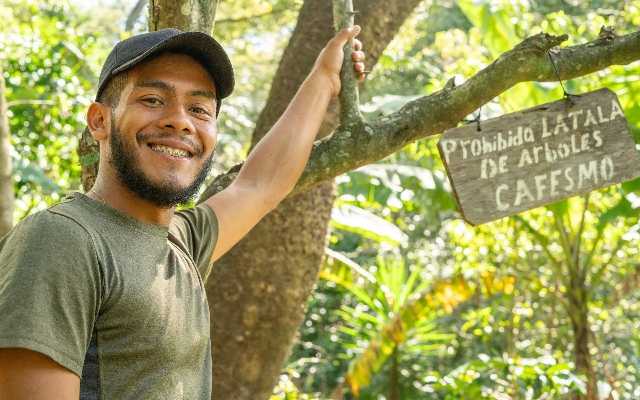HAMBURG, Germany – The initiative for coffee&climate (c&c) presents its roadmap for the next five years. Until 2028, it extends its focus from the farm and community to the landscape level in climate-smart coffee growing. Implementing sustainable land-use systems such as agroforestry and regenerative agriculture, c&c intensifies its efforts aiming at carbon reduction and sequestration as well as better food security for smallholder coffee farming households.
coffee&climate (c&c) is an initiative of dedicated global coffee companies. Together with smallholder farming communities and a network of research organizations, they explore best practices in climate adaptation and mitigation in coffee production. Operating since 2010, c&c has become the reference point and knowledge hub for climate change in the coffee sector. Kathrine Löfberg, Chair of c&c and Chair of the Board of Löfbergs emphasizes: “We as committed companies, all strive to support coffee families in becoming climate resilient, that is our ultimate goal.”
coffee&climate: extending the activities from the farm and community to the landscape level
In the past years, c&c’s measures have been aiming at climate-resilient livelihoods of smallholder coffee farming families, minimizing carbon emissions and enhancing the carbon storage potential in coffee farms.
Now c&c is expanding its focus by integrating more aspects that are highlighted as important by climate impact research. This includes promoting sustainable land use systems such as agroforestry and regenerative agriculture as well as water management.
With its approach to climate-smart coffee regions, c&c extends its activities from the farm and community level to the landscape level to increase the overall climate resilience on a broader scale. c&c cooperates with various stakeholders on site to assess the respective landscape and develop joint action plans.
“The process of improving climate resilience and livelihoods has to start at the farm level, but beyond that, you have to think in terms of landscape”, explains coffee&climate Program Manager Stefan Ruge. “If it is about reforesting an area or protecting a watercourse, activities can’t be limited to individual farms.” It is important to look at the existing forms of agricultural use and not stop at district or federal state boundaries. “All this is only possible because we keep pursuing a participatory approach which means including smallholder farmers and other local stakeholders in the decision-making processes”, Ruge underlines.
Identifying the most suitable carbon reduction and sequestration strategies
Since coffee as a cash crop plays an important role in sustaining millions of livelihoods around the world, it is critical to understand how and where greenhouse gas emissions are emitted from coffee production and processing. c&c will conduct carbon footprint analyses at farm and household level in all c&c program regions.
“Quantification of greenhouse gas emissions reductions resulting from mitigation measures is arguably irrelevant if their livelihood effects are ignored”, Stefan Ruge points out. “And scaling greenhouse gas emissions per unit area is agronomically meaningless if the entire production system is not considered. Therefore, c&c aims to identify the most suitable carbon reduction and sequestration strategies per region.”
Implementing sustainable land use systems contributes to carbon reduction and sequestration alongside providing various other benefits such as better food security and income sources.
Improving food security as an essential prerequisite for livelihood and climate resilience
Also, the topic of food security gains growing relevance in c&c’s activities. Food security is a human right that is increasingly put at risk by the impacts of climate change. Particularly in coffee-growing regions, food security is an issue. This is because of an unstable food supply but also often because farmers focus on cash crop production rather than on food production. At the same time, food security is an essential precondition for coffee farming families to successfully produce their cash crop, improve their livelihoods, and enhance their resilience against climate change. c&c will therefore intensify its promotion of climate-smart practices that improve the families’ food security at the same time.
c&c will address these important topics in the next five years. “c&c’s work and impact is made possible through the cooperation of the coffee sector and the support of public institutions”, emphasizes Kathrine Löfberg. “Only by working together and using synergies can we make change happen.”

















